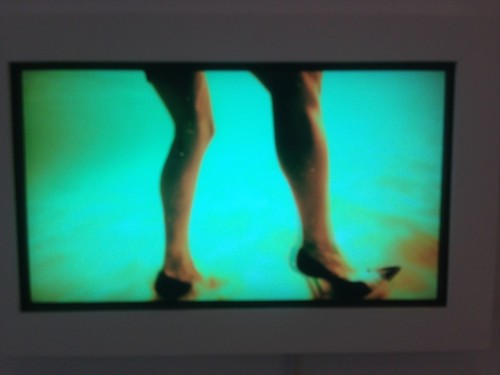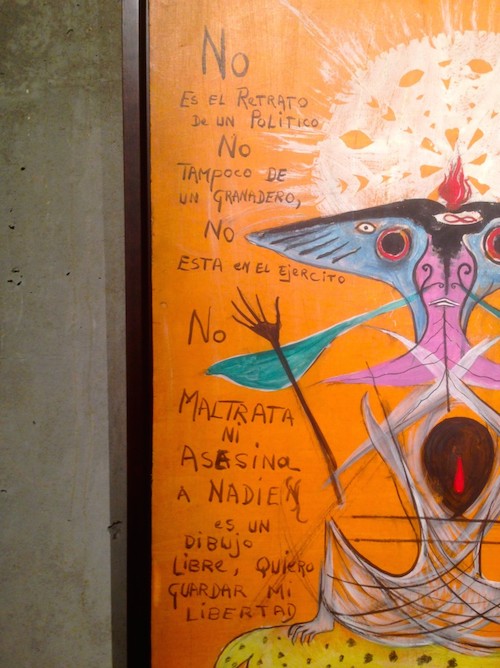Gallery Wendi Norris in San Francisco opened a show this week for the local artist Ana Teresa Fernandez, and in a smaller side room here are a variety of works in several media by the late Surrealist painter Leonora Carrington (1917-2011).

Fernandez’ work (in sculpture, video, paint and good old fashioned “installation”) is pretty sensational, with its repeated reference to a powerful horse bolting slowly through ocean tides, filmed from the withers down, its powerful legs and body moving freely through lovely water—we can’t seem to see above the level of the water, we strain to glimpse the horse’s head. Counterposed with this repeated image, we see a woman’s body also moving through the wet sands, her head apparently above water; she’s formally dressed in a dark cocktail dress and imposing Ru-Paul esque high heels. Her progress through tonnes of water is less elegant, less effective than that of the horse—it’s a bit like the old claim about Ginger Rogers doing everything Astaire did, but backwards and in high heels yet never breaking a sweat. This woman is not finding it easy—a surreal anxiety burrows at the root of this work, as if Maya Deren had made a film in which we never see her face, to publicly declare her membership in Georges Bataille’s Societe d’Acephale (the headless state in which Bataille hoped to achieve a release from the travails of the mind and of ethics). The paintings are big, imposing, realistically treated, and in some of them we see the woman’s face in a dry interior, well, strips of it, clues about what she looks like—the same fantastic Tina Turner legs with Tina’s ferocious shoes re-appear, so I almost think it’s she.
Around the corner we walk into another world, this one the “Irish Carrington,” who rejected the simple patterns of Surrealist ideology in which a woman could appear only as a muse; instead how was a woman to claim the status of artist herself, when so little in the entire apparatus of Western thought gave such woman any hope, any sustenance. And so by trial and error she developed a unique palette of images and surfaces and her own ancestry, and here the Celtic sorcery appears, however decadent or oddly-fangled it was made to seem. I think of the Scottish-born, American-based poet Helen Adam, who used traditional ballad form to comment not only on tragedies of folk legend but on current social phenomena in the postwar period in which she did her greatest work—in the civil rights struggle “(Miss Laura”), in the drug culture (“Cheerless Junkie’s Song”), in the culture of the atom bomb (“The Limbo Gate”).

The gallery is showing many beautiful works by Carrington, but my favorite is the bright, bizarre, funereal Lepidoptera from 1968. Few paintings have been so precisely dated—“1968 13th Agosto” it says in bold underlining big as her name at the bottom of the picture, and we recognize Carrington’s longheld passion for Mexican affairs; we know that August 1968 saw the student uprising and the Situationist-inspired occupation of Zocalo Plaza—the occupation that was to end tragically in October with the notorious massacre by the state police and army, a wipeout medieval in its savagery. What are we looking at? Through orange sands stalks the two headed leopard (one head that of a bird) on the back of which crouches a black figure, dressed in cobwebs, its arms and hands extended akimbo in appeal—on top, a figure thst combines elements of fish, fowl, and lepidoptera—the order of the moth and butterfly, an eye on either wing, a flame emitting scandal from its scalp, and an explosion of white paint in lacy patterns of centripetal elegance, but hideous somehow. Down the right edge of the picture, Carrington has written out stanza 2 of John Donne’s Caroline era poem “The Damp,” one of his more mordant analyses of the war between men’s and women’s sexual powers. The poem begins when the speaker imagines that after his death, anatomists will find her face stamped upon his heart, and pictures his lover’s own face agloat with the sexual triumph of such a feat. In verse two, he addresses her directly.
Poor victories; but if you dare be brave,
And pleasure in your conquest have,
First kill th’ enormous giant, your Disdain;
And let th’ enchantress Honour, next be slain;
And like a Goth and Vandal rise,
Deface records and histories
Of your own arts and triumphs over men,
And without such advantage kill me then,
On the painting’s opposite side Carrington has written her own manifesto, in Spanish, in more direct apposition to the student occupation. I could make out a word here and here—“politico,” “grenadera.” I copied down the words of the text and brought them to my friend, the Mexican-born Berkeley-based poet and translator Hugo Garcia Manriquez, who very kindly gave them back to me as follows:
That is the Lepidoptera (the title strung across the top of the picture)
IT'S NOT
the portrait
of a politician
NOR
of a riot
policeman
IT'S NOT
enlisted in the army
IT DOES NOT
mistreat
nor kills anyone
It's a free
drawing, I want
to keep my
liberty
Hugo and I each noticed with amusement and admiration that Carrington must have been writing/painting at such white hot speed that several words are spelled wrongly, and it looks like later she just corrected them with no shame about the cross-out, so that all her “errors” remain visible, perhaps part of the poem itself. Hugo writes:
It is an astonishing and mysterious painting, especially against the turmoil of those days [...] Yes, you are absolutely right, there are, at least, a couple of obvious slips ASASINOS, and corrected, ASESINOS. Interestingly, there's another word NADIE, which she spells NADIE(N), this is an odd mistake, it’s not "incorrect," it's more of a social marker --common in low-working class speech, NADIE(N), and turned the N into a letter-drawing, almost a symbol for paragraph, §.
Hugo added, "The overwriting of the text captures and foregrounds, poignantly, the interplay of policing (collective) grammars and the (ultimately lethal) policing of insurrection in Mexico, during those days. The painting seems to says, Assassin is an Asesino, in any language." Against this imperative of “free drawing,” what is the implication of her reboot of Donne implying, and what of the multiple beast slouching towards a future unknown, but ominous? Who could work all of this out except to note that the lovers of “The Damp,” who seem like ancient gods in never-ending battle of wits the speaker longs to conclude in mutual mercy, have been transmuted into actual deaths of actual monsters and miracle creatures. No metaphor, only the Celtic and pre-Columbian imaginary? Only occupation?
Poet, novelist, playwright, art critic, and scholar Kevin Killian earned a BA at Fordham University ...
Read Full Biography

